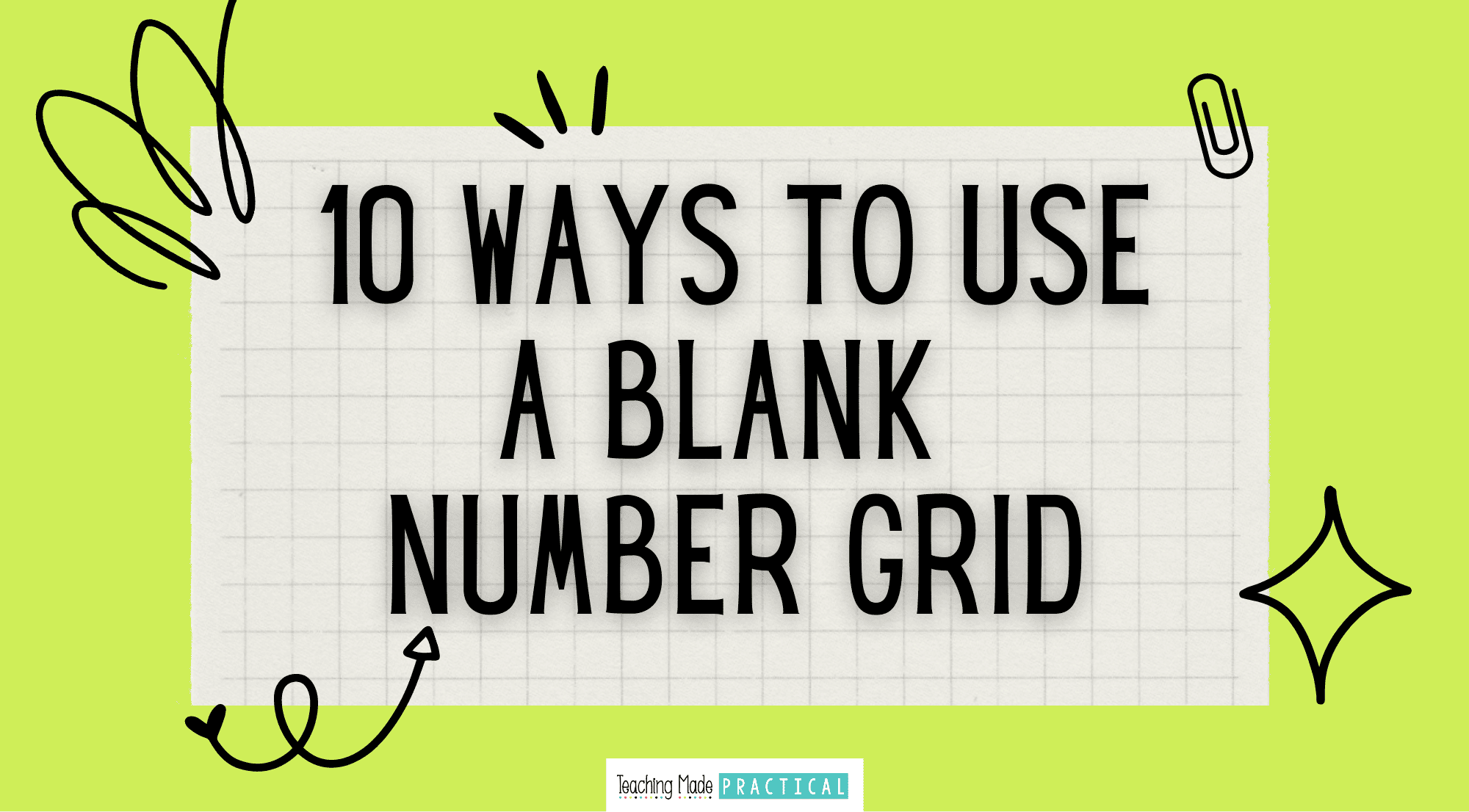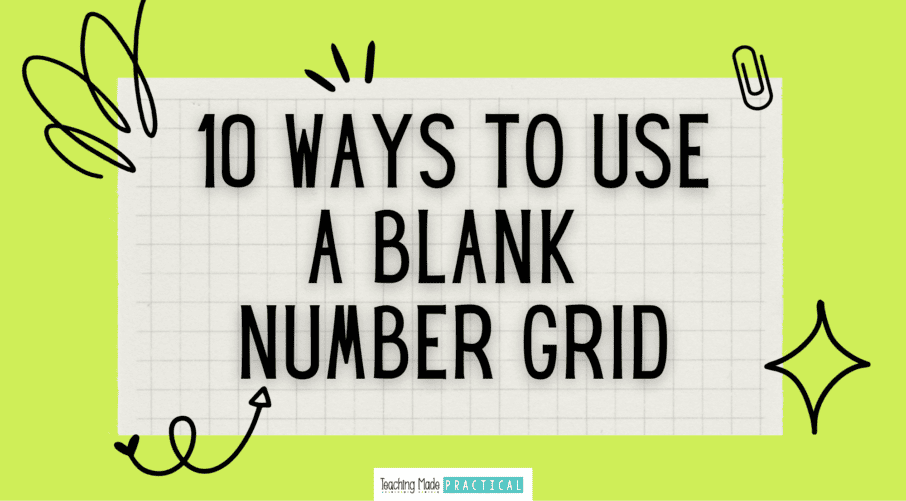
Ever had one of those days? The kind where you are constantly interrupted by ridiculousness from your 3rd, 4th, or 5th grade studetns? The end of the day was finally approaching, and I'll admit it - I was exhausted. And my math block was almost over, having been taken up by several behavior problems (one of which involved fireworks).
There was absolutely no way my students would benefit from a rushed lesson, so I adjusted my plans. I gave each student a Blank Number Grid and asked them to write 951 in the first square, and then count by ones until the grid was completely filled up.
I thought this activity would keep my students busy and quiet while I tried to recoup. Not only was I wrong, but I was absolutely HORRIFIED by the results.
A few of my students couldn't even make it past 959 without needing my help. A much larger group got stuck at either 999 or 1,000 before calling for assistance. Several of the students didn't even realize they needed my help - they successfully made it to 1,000 and then confidently wrote: 1,100; 1,200; 1,300, 1,400, etc. A very precious few managed to fill in the number grid without any errors.
Ever since that day, I've been using a blank number grid as a very simple way to assess my students' place value skills, and I've discovered several other NO PREP ways to use blank number grids in the classroom. My favorites for 3rd, 4th, and 5th grade are below.
10 Number Grid Activity Ideas
1. Use Number Grids to Find Patterns

2. Count (Using Large Numbers) for Place Value Practice
This one's simple - and it's an incredibly valuable assessment tool. Instead of using a number grid to count to 100, have students count by larger numbers. Tell students what number they should start on, and let them count.
This activity is incredibly easy to differentiate. Have some students practice counting in the hundreds, starting with a number like 201. Other students can practice counting in the thousands, starting with a number like 1,501. Still others can practice counting in the ten-thousands, starting with a number like 12,901.
Fun, No Prep Halloween ELA Activities! Includes:
- Halloween Fun Packet
- History of Halloween Reading Passage
- Monster Descriptive Writing Activity
- Spooky Figurative Language
- Bats Reading Comprehension and Snowball Fight
3. Count, Starting at a Variety of Numbers
Most number grids start with a number that has either a 0 or 1 in the ones place. Instead, have students start counting on their number grid at a variety of numbers. Have some students start with a number like 54, others at 117, others at 333, etc.
Then, have students look for patterns and compare the patterns they found with other students. Hopefully students will see that the patterns remain similar, no matter what they start on. For example, all the numbers in a column should have the same digit in the ones place.
Once again this is easy to differentiate, yet all students would be able to contribute to the class discussion. More advanced students can start at larger numbers, while struggling students can practice counting on their own level.

4. Students Create a Fill-in-the Blank Number Grid
Give students a blank number grid and have them count, assigning them a starting number of having them choose their own starting number. As they count, have them leave many of the boxes in the number grid blank.
Once they are finished, students can trade number grids with a partner, having their partner fill in the missing numbers. This activity can also work as a small group math center.
5. Number Grid Puzzles
Give each student a blank number grid, and tell them what number goes in the first box (the higher the number, the more challenging the puzzle). Then, call out a variety of numbers, having students write those numbers in the correct spot on the number grid.
Make sure the numbers you call out all have a spot on the blank number grid. If you had students start with the number 781, for example, then the number 899 would be too large and wouldn't fit on that specific number grid.
The goal is for students to use what they know about number grid patterns to place numbers in the number grid efficiently rather than simply counting by ones to find the correct location.
6. Count By Multiples
This activity is helpful for students learning their multiplication facts or learning divisibility rules. Simply have students count by multiples. (You might also like this free multiples activity.)
Differentiate by having students count by the multiples of whatever multiplication facts they are working on. Students struggling with multiplying by 3 can practice counting by multiples of 3. Your more advanced learners could count by multiples of 9, 12, 15, or other numbers.
Before beginning this activity, it will be important for students to understand that the number grid patterns they are familiar with don't necessarily apply when you are no longer counting by 1s. However, math is all about patterns and students should be encouraged to find new patterns based on whatever multiple they are counting by.
When first learning about the rules of divisibility, looking for patterns this way can be a valuable lesson. For example, students who are counting by multiples of 4 should learn that all multiples of 4 are even numbers.
Students that are counting by multiples of 9 should compare their work with somebody who counted by multiples of 3 - hopefully students will notice that ANY multiple of 9 is also a multiple of 3.
7. Find Prime and Composite Numbers
When introducing prime numbers to students, a number grid can be a valuable tool. A similar method was used by Eratosthenes, a Greek mathematician, to find prime numbers.
Have students fill in their blank number grid, starting with the number 1. Then, begin the process of finding prime numbers.

Have students cross out 1, explaining that 1 is a special number you will discuss later. Then, explain to students that every time they come to a number that is not crossed out, they will circle it and then cross out its multiples.
For example, the next uncrossed out number on the number grid is 2. Have students circle the 2, and then cross out all of its multiples. Do the same with 3. Then, the next number should be 4, but it is already crossed out. Have students move on to the number 5 - circle it, and then cross out all multiples of 5.
Continue this process until you have circled all of the prime numbers. Guide students in a discussion that helps them figure out what is similar about all of the prime numbers and composite numbers. (A prime number will only have 2 factors - 1 and itself. A composite number will have more than 2 factors. The number 1 is special because its only factor is 1.)
8. Count By Fractions
Many times teachers focus so much on fractions less than 1 that students develop misunderstandings about how fractions greater than 1 work. Help prevent this misunderstanding by having students count by different fractions, just like they count by whole numbers.
Although students could use a blank 10 x 10 number grid to count by different fractions, it will be more beneficial to their understanding if the number grid has the same amount of columns as the number in the denominator. So, if you want students to count by 1/4, have them cut their number grid so that it only has 4 columns. This will allow students to identify patterns when counting by different fractions.
9. Count By Decimals
When teaching decimals, have students use a blank number grid to count by tenths or hundredths. This is a simple activity that will help you assess your students' understanding of decimals.
If you have students counting by tenths, particularly check to make sure they understand that after .9 is the whole number 1.
If you have student counting by hundredths, make sure students know that .1 comes after .09.


10. Develop an Understanding of Decimal / Fraction Conversions
It is important for students to know important decimal/fraction conversions. For example, students should know that .5 is equivalent to one half, and .25 is equivalent to one fourth. Use this activity to introduce these important conversions.
Have students count by hundredths, starting with .01 and ending with 1 whole. Make sure students understand how this relates to fractions - this is one whole, divided into 100 equal parts.
Then, have students shade in exactly half of the number grid. They should discover that half of the number grid is equivalent to .5.
Repeat this activity with a new number grid (or the same number grid, shading in a different color), and have students shade one fourth of the grid. They should discover that one fourth is the same as .25.
Save Time By Making Extra Copies
Since I knew I would use number grids a variety of times throughout the school year, I would make a lot of copies at the beginning of the year and store them with my other reusable activities. This saved me time making copies later on.
Several of these activities can be repeated multiple times and still benefit students (counting by multiples, counting by larger numbers, counting by fractions, etc.), so I would sometimes use this as a back up activity in case something came up that required my attention or as an extra activity for my sub tub. Used sparingly, my students actually enjoyed counting, it kept them occupied and quiet for extended periods of time, and it helped build their place value skills!
Never Stress Over Sub Plans Again!

Make copies, find a fiction book, and you'll be ready for any emergency that comes your way!



Comments 3
Great idea! We do assume that students understand and know how to count. We also assume that they can make connections between the value of numbers when counting by decimal numbers. Huge mistake. Using grids really helped my students understand the order of numbers when counting by tenths, hundredths, and thousandths. Great idea! I am so glad I found your site this morning. I think I may blog about my experience using grids once I complete this lesson with my second class. Thank you for sharing! Happy blogging and happy teaching! 🙂
Krystal L. Smith
Author
If you did blog about it, post a link so I can check it out!
Love these ideas!!! Thank you. 🙂